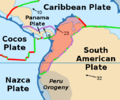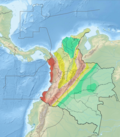| UTC time | Doublet earthquake: |
|---|---|
| 1868-08-15 19:30 | |
| 1868-08-16 06:30 | |
| Local date | |
| 15 August 1868 | |
| 16 August 1868 | |
| Local time | |
| Afternoon | |
| 01:30 | |
| Magnitude | |
| 6.3 Mw [1] | |
| 6.7 Mw [1] | |
| Depth | 20 km |
| Epicenter | 0°19′N78°11′W / 0.31°N 78.18°W |
| Areas affected | Ecuador, Colombia |
| Max. intensity | MMI VIII (Severe) MMI X (Extreme) |
| Casualties | 70,000 [2] |


The 1868 Ecuador earthquakes occurred at 19:30 UTC on August 15 and 06:30 UTC on 16 August 1868. They caused severe damage in the northeastern part of Ecuador and in southwestern Colombia. They had an estimated magnitude of 6.3 and 6.7 [1] and together caused up to 70,000 casualties. [2] The earthquake of 15 August occurred near El Ángel, Carchi Province, close to the border with Colombia, while that of August 16 occurred near Ibarra in Imbabura Province. [1] Reports of these earthquakes are often confused with the effects of the earthquake of 13 August at Arica. [2]



